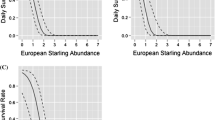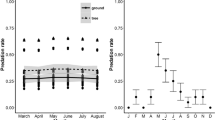Abstract
To date, most studies of nest site selection have failed to take into account more than one source of nest loss (or have combined all sources in one analysis) when examining nest site characteristics, leaving us with an incomplete understanding of the potential trade-offs that individuals may face when selecting a nest site. Our objectives were to determine whether northern flickers (Colaptes auratus) may experience a trade-off in nest site selection in response to mammalian nest predation and nest loss to a cavity nest competitor (European starling, Sturnus vulgaris). We also document within-season temporal patterns of these two sources of nest loss with the hypothesis that flickers may also be constrained in the timing of reproduction under both predatory and competitive influence. Mammalian predators frequently depredated flicker nests that were: lower to the ground, less concealed by vegetation around the cavity entrance and at the base of the nest tree, closer to coniferous forest edges and in forest clumps with a high percentage of conifer content. Proximity to coniferous edges or coniferous trees increased the probability of nest predation, but nests near conifers were less likely to be lost to starlings. Flickers may thus face a trade-off in nest site selection with respect to safety from predators or competitors. Models suggested that peaks of nest predation and nest loss to eviction occurred at the same time, although a competing model suggested that the peak of nest loss to starlings occurred 5 days earlier than the peak of mammalian predation. Differences in peaks of mammalian predation and loss to starlings may constrain any adjustment in clutch initiation date by flickers to avoid one source of nest loss.




Similar content being viewed by others
References
Aitken KEH, Martin K (2004) Nest cavity availability and selection in aspen-conifer groves in a grassland landscape. Can J For Res 34:2099–2109
Aitken KEH, Wiebe KL, Martin K (2002) Nest-site reuse patterns for a cavity nesting bird community in interior British Columbia. Auk 119:391–402
Banks AJ, Martin TE (2001) Host activity and the risk of nest parasitism by brown-headed cowbirds. Behav Ecol 12:31–40
Bayne EM, Hobson KA (2002) Effects of red squirrel (Tamiasciurus hudsonicus) removal on survival of artificial songbird nests in boreal forest fragments. Am Midl Nat 147:72–79
Bayne EM, Hobson KA, Fargey P (1997) Predation on artificial nests in relation to forest type: contrasting the use of quail and plasticine eggs. Ecography 20:233–239
Burnham P, Anderson DR (1998) Model selection and influence: a practical information–theoretical approach. 1st edn Springer, New York
Christman BJ, Dhondt AA (1997) Nest predation in black-capped chickadees: how safe are cavity nests?. Auk 114:769–773
Clark RG, Shutler D (1999) Avian habitat selection: pattern from process in nest-site use by ducks?. Ecology 80:272–287
Compton BW, Rhymer JM, McCollough M (2002) Habitat selection by wood turtles (Clemmys insculpta): an application of paired logistic regression. Ecology 83:833–843
Cresswell W (1997) Nest predation: the relative effects of nest characteristics, clutch size and parental behaviour. Anim Behav 53:93–103
Crowder LB, Squires DD, Rice JA (1997) Nonadditive effects of terrestrial and aquatic predators on juvenile estuarine fish. Ecology 78:1796–1804
De Santo TL, Willson MF, Bartecchi KM, Weinstein J (2003) Variation in nest sites, nesting success, territory size, and frequency of polygyny in winter wrens in northern temperate coniferous forests. Wilson Bull 115:29–37
Dinsmore SJ, White GC, Knopf FL (2002) Advanced techniques for modeling avian nest survival. Ecology 83:3476–3488
Dobkin DS, Rich AC, Pretare JA, Pyle WH (1995) Nest-site relationships among cavity-nesting birds of riparian and snowpocket aspen woodlands in the northwestern Great Basin. Condor 97:694–707
Evans MR, Lank DB, Boyd WS, Cooke F (2002) A comparison of the characteristics and fate of barrow’s goldeneye and bufflehead nests in nest boxes and natural cavities. Condor 104:610–619
Feare CJ (1984) The Starling. Oxford University Press, Oxford
Filliater TS, Breitwisch R, Nealen PM (1994) Predation on northern cardinal nests: does choice of nest site matter? Condor 96:761–768
Gutzwiller KJ, Anderson SH (1987) Multiscale associations between cavity-nesting birds and features of Wyoming streamside woodlands. Condor 89:534–548
Holt RF, Martin K (1997) Landscape modification and patch selection: the demography of two secondary cavity nesters colonizing clearcuts. Auk 114:443–455
Hooge PN, Stanback MT, Koenig WD (1999) Nest-site selection in the acorn woodpecker. Auk 116:45–54
Hosmer DW, Lemeshow SL (2000) Applied logistic regression, 2nd edn. Wiley, New York
Julliard R, McCleery RH, Clobert J, Perrins CM (1997) Phenotypic adjustment of clutch size due to nest predation in the great tit. Ecology 78:392–404
Kappes JJ (1997) Defining cavity-associated interactions between Red Cockaded Woodpeckers and other cavity-dependent species: interspecific competition or cavity kleptoparasitism. Auk 114:779–780
Koenig WD (2003) European Starlings and their effect on native cavity-nesting birds. Conserv Biol 17:1134–1140
Lahti DC (2001) The “edge effect on nest predation” hypothesis after twenty years. Biol Conserv 99:365–374
Li P, Martin TE (1991) Nest-site selection and nesting success of cavity-nesting birds in high elevation forest drainages. Auk 108:405–418
Martin K, Eadie JM (1999) Nest webs: a community-wide approach to the management and conservation of cavity-nesting forest birds. For Ecol Manage 115:243–257
Martin TE (1992) Breeding productivity considerations: what are the appropriate habitat features for management?. In: Hagan JM III, Johnston DW (eds) Ecology and conservation of Neotropical migrant landbirds. Smithson Inst Press, Washington, pp 455–473
Martin TE (1993) Nest predation and nest sites: new perspectives on old patterns. Bioscience 43:523–533
Martin TE, Li P (1992) Life history traits of open- vs. cavity-nesting birds. Ecology 73:579–592
Mayfield H (1961) Nesting success calculated from exposure. Wilson Bull 73:255–261
Mazgajski TD (2002) Nesting interaction between woodpeckers and starlings- delayed commensalisms, competition for nest sites or cavity kleptoparasitism?. In: Pechacek P, D’Oleire-Oltmanns W (eds) Proceedings international woodpecker symposium, Forschungsbericht 48, Nationalparkverwaltung Berschtesgaden, pp 133–138
Mazgajski TD (2003) Nest site choice in relation to the presence of old nests and cavity depth in the starling Sturnus vulgaris. Ethol Ecol Evol 15:273–281
Moore WS (1995) Northern flicker: Colaptes auratus. In: Poole A, Gill F (eds) The Birds of North America, no 166. The Academy of Natural Sciences, Philadelphia; The American Ornithologist’s Union, Washington, DC
Møller AP (1989) Parasites, predators and nest boxes: facts and artifacts in nest box studies of birds? Oikos 56:421–423
Niemuth ND, Boyce MS (1995) Spatial and temporal patterns of predation of simulated sage grouse nests at high and low nest densities: an experimental study. Can J Zool 73:819–825
Nilsson SG (1984) The evolution of nest-site selection among hole-nesting birds: the importance of nest predation and competition. Ornis Scand 15:167–175
Nilsson SG (1986) Evolution of hole-nesting in birds: on balancing selection pressures. Auk 103:432–435
Paton PW (1994) The effect of edge on avian nest success: how strong is the evidence? Conserv Biol 8:17–26
Pelech SA (1999) Habitat use and nest searching success of red squirrels at a forest edge. MSc Thesis, University of British Columbia
Peterson B, Gauthier G (1985) Nest site use by cavity-nesting birds of the cariboo parkland, British Columbia. Wilson Bull 97:319–331
Pribil S, Picman J (1997) The importance of using the proper methodology and spatial scale in the study of habitat selection by birds. Can J Zool 75:1835–1844
Purcell KL, Verner J (1999) Nest predators of open and cavity nesting birds in Oak woodlands. Wilson Bull 111:251–256
Rauter CM, Reyer H, Bollmann K (2002) Selection through predation, snowfall and microclimate on nest-site preferences in the water pipit Anthus spinoletta. Ibis 144:433–444
Rendell WB, Robertson RJ (1989) Nest-site characteristics reproductive success and cavity availability for tree swallows breeding in natural cavities. Condor 91:875–885
Sandstrom U (1991) Enhanced predation rates on cavity nests at deciduous forest edges: an experimental study. Ornis Fenn 68:93–98
Sih A, Englund G, Wooster D (1998) Emergent impacts of multiple predators on prey. Trends Ecol Evol 13:350–355
Sonerud GA (1985) Nest hole shift in tengmalm’s owl Aegolius funerus as defence against nest predation involving long-term memory in the predator. J Anim Ecol 54:179–192
Templeton CN, Shriner WM (2004) Multiple selection pressures influence trinidadian guppy (Poecilia reticulata) antipredator behavior. Behav Ecol 15:673–678
Tracy N. (1938) Der grosse Bunspecht. Beiträge zur Fortpflanzungsbiologie der Vögel 14:41–48
Walters EL, Miller EH (2001) Predation on nesting woodpeckers in British Columbia. Can Field Nat 115:413–419
Wesolowski T (2002) Anti-predator adaptations in nesting marsh tits Parus palustris: the role of nest-site security. Ibis 144:593–601
Wiebe KL (2003) Delayed timing as a strategy to avoid nest-site competition: testing a model using data from starlings and flickers. Oikos 100:291–298
Wiebe KL, Swift TL (2001) Clutch size relative to tree cavity size in northern flickers. J Avian Biol 32:167–173
Witkander U, Olson O, Nilsson SG (2001) Annual and seasonal reproductive trends in the lesser spotted woodpecker Dendrocopus minor. Ibis 143:72–82
Willson MF, De Santo TL, Sieving KE (2003) Red squirrels and predation risk to bird nests in northern forests. Can J Zool 81:1202–1208
Willson MF, Gende SM (2000) Nesting success of forest birds in southeast Alaska and adjacent Canada. Condor 102: 314–325
Acknowledgements
We would like to thank R. G. Clark, G. R. Bortolotti, and S. G. Sealy for comments on earlier drafts of this manuscript. We also thank the numerous field assistants that helped us monitor flicker nest sites throughout the years and the Department of National Defence that allowed us access to their land. This project was funded through an NSERC and SIBTS scholarship to RJF and an NSERC operating grant to KLW.
Author information
Authors and Affiliations
Corresponding author
Additional information
Communicated by Scott Robinson
Rights and permissions
About this article
Cite this article
Fisher, R.J., Wiebe, K.L. Nest site attributes and temporal patterns of northern flicker nest loss: effects of predation and competition. Oecologia 147, 744–753 (2006). https://doi.org/10.1007/s00442-005-0310-2
Received:
Accepted:
Published:
Issue Date:
DOI: https://doi.org/10.1007/s00442-005-0310-2




